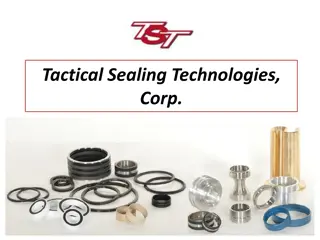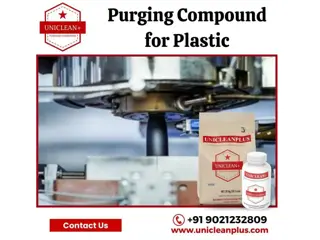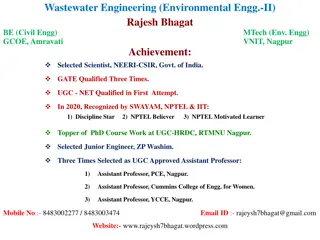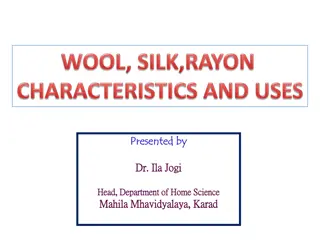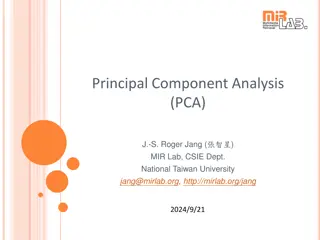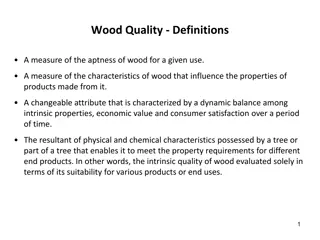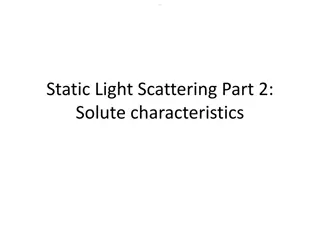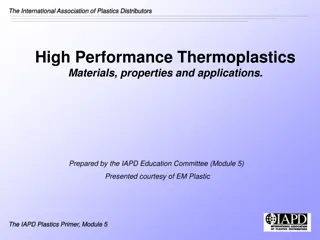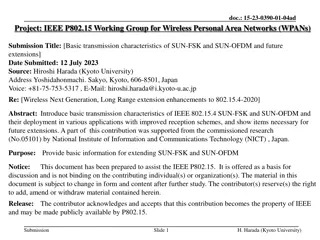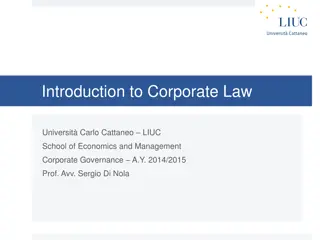Understanding Thermoplastics: Characteristics and Applications
Thermoplastics are solid at room temperature but become viscous liquids when heated, allowing them to be easily shaped into various products. They are pliable above a specific temperature and return to a solid state upon cooling. Commonly used engineering thermoplastics include Nylon, Polycarbonate, PET, and PP, known for their toughness, stiffness, and suitability for advanced applications. Thermoplastics have properties like toughness, resistance to acids and bases, high hardness, and good flame-retardant capabilities, making them versatile materials in various industries.
Download Presentation

Please find below an Image/Link to download the presentation.
The content on the website is provided AS IS for your information and personal use only. It may not be sold, licensed, or shared on other websites without obtaining consent from the author. Download presentation by click this link. If you encounter any issues during the download, it is possible that the publisher has removed the file from their server.
E N D
Presentation Transcript
PLASTICS - CLASSIFICATION Thermosets Thermoplastics Elastomers
thermoplastics thermoplastics are solid materials at room temperature but viscous liquids when heated to temperatures of only a few hundred degrees This characteristic allows them to be easily and economically shaped into products They can be subjected to heating and cooling cycles repeatedly degradation Symbolized by TP. without significant
thermoplastics A thermoplastic, also called a thermo-softening plastic is a plastic which becomes pliable or moldable above a specific temperature and returns to a solid state upon cooling. Most thermoplastics have a high molecular weight. Polymers which molds above Glass transition temperature and returns to normal state upon cooling. CHARACTERISTIC: More aesthetically pleasing, Stronger and stiffer but lower toughness, expensive forming processes, less resistance to mechanical creep, not suitable for use in extremely temperatures, little to no cross-linking in microstructure, eco-friendly forming process.
Thermoplastics Polymers which moulds above Glass transition temperature and returns to normal state upon cooling is called thermoplastics polymers
Thermoplastics Most commonly used engineering thermoplastics as matrices Nylon Polycarbonate (PC) Polyethylene terephthalate (PET) Polypropylene (PP) Stronger and stiffer but lower toughness Have engineering as well as advanced applications.
Properties of thermoplastics Tough lightweight material that is resistant to acids and bases. High hardness high modulus of elasticity (rigid-type), very low modulus of elasticity (flexible) Poor heat stability, small expansion coefficient Good flame retarding(delaying) Electrical insulator Can be remolded and recycled
Types of thermoplastics polymers Polyvinyl chloride(PVC). It is a tough, lightweight material that is resistant to acids and bases. Much of it is used by the construction industry , such as for vinyl siding, drainpipes, gutters and roofing sheets. It is also converted to flexible forms with the addition of plasticizers, thereby making it useful for items such as hoses, tubing, electrical insulation, coats, jackets and upholstery. Flexible PVC is also used in inflatable products, such as water beds and pool toys. Poly-propylene. It is useful for reusable plastic food containers, microwave- and dishwasher-safe plastic containers, casing , ropes , carpets, plastic moldings, piping systems, car batteries, insulation for electrical cables and filters for gases and liquids. It is also used for making heat-resistant medical equipment. Polypropylene sheets are used for stationery folders and packaging and clear storage bins.
Types of thermoplastics polymers Poly-ethylene It is used to manufacture moving machine parts artificial joints and some bulletproof vests. High-density polyethylene (HDPE), recyclable plastic no. 2, is commonly used as milk jugs, liquid laundry detergent bottles , outdoor furniture, margarine tubs portable gasoline cans, drinking water distribution systems, water drainage pipes, and grocery bags. Medium-density polyethylene (MDPE) is used for packaging film, sacks and gas pipes and fittings , bearings, gears, , Methacrylate. It serves as a sturdy substitute for glass for items motorcycle helmet visors tahdid, aircraft windows, viewing ports of submersibles, and lenses of exterior lights of automobiles. In medicine, it is used in bone cement and to replace eye lenses. Acrylic paint consists of PMMA particles suspended in water. such as aquariums,
APPLICATION Methacrylate AS A BUILDING MATERIAL Construction professionals select plastic materials based on the following criteria: 1. Durability: Plastic hardware is corrosion resistant and hence can survive harsh weather. conditions. 2. Cost Effectiveness 3. Recyclable: To reduce harmful waste accumulation on the site. 4. Energy Saving: Plastic consumes less heat than metal, hence the insulating effects of some plastics can decrease sound pollution level. 5. Ease of installations. 6. Maintenance required- less.
APPLICATION APPLICATION 7. Domes and Skylight 8. Roofing 9. Windows and Doors Polycarbonate a material also used in eyeglasses is used as panes(parts). These are clear, lightweight, shatter-resistant have low thermal conductivity, which can help to reduce heating and cooling costs. Vinyl window frames are inherently(naturally) energy efficient and can save trillion thermal units of energy per year, helping reduce the greenhouse gas emissions associated with energy generation all the while cutting maintenance time, materials and costs. 10. Hardware Accessories Washers, nuts, bolts, sleeves, anchoring wires. plastic products
APPLICATION Flooring : Thermoplastic vinyl tiles these tiles are laid on dry and clean floor on cut back bitumen adhesives spread and rolled with light rollers. These tiles are unaffected by water , oil and grease . PVC Sheets 1mm thick and are provided with cheaper backing material. For better adhesion these sheets are roughened on the under side. Flooring tiles and rolls. Temporary Structures Guard cabins , tents. Decorated Laminated Plastic Sheet Tough , durable , available in variety of colour and texture.
Effect of temperature Above glass-transition temp. polymers become leathery and then rubbery At higher temperatures, polymers become a viscous fluid, with viscosity decreasing with increasing temperture.
Glass transition temperature Amorphous polymers do not have a specific melting point. At low temp., they are hard, brittle, rigid and glassy and at a high temp. rubbery and leathery. The temperature at which this transition occurs is called Glass transition temperature (Tg).
Behavior under temperature conditions Below temperature Tg, plastic polymers are glassy ,rigid, hard or brittle and behave as a elastic body. If the load exceeds the certain critical value, it fractures as a piece of glass 1. Elastic deformation 2. Viscous deformation 3. Maxwell Model of Viscoelastic deformation 4. Voigt or Kelvin Model of Viscoelastic deformation
Viscoelastic behavior When heated above Tg , It becomes leathery first and then rubbery with increasing temperature If we increase above Tm (melting point ), it becomes viscous and viscosity goes on decreasing with increase in temperature and strain rate As viscosity is not constant, thermoplastic shows visco- elastic behavior
Orientation When thermoplastics are permanently deformed by stretching, long chain molecules align in general direction of elongation. This is known as orientation. The polymer becomes stiffer and stronger in the elongation direction as compared to transverse direction This technique is used to enhance the strength and toughness of polymers
Water absorption This is limitation of thermoplastics Water acts as plasticizing agent. Thus, it makes polymer more plastic It lowers the glass transition temperature, yield stress and elastic modulus of polymer Sometimes, Undesired dimensional changes occur
Amorphous thermoplastic polymers Molecule chains are completely chaotically arranged and tangled with each other like the threads of a cotton wool pad amorphous structure means that these materials cannot be subjected to loads above the glass transition point Properties : Low tendency to creep Good dimensional stability Tendency to brittleness Sensitive to stress cracking
Semi-crystalline thermoplastics Molecules form crystalline structure Due to the crystalline areas, the materials are extremely tough (strong intermolecular forces) and are capable of withstanding mechanical loads Properties : Opaque Good fatigue resistance Tendency to toughness Good chemical resistance Wear resistance
Acetals or Polyoxymethylenes (POM) and Polyamides characteristics Mechanical do not brittle, good impact strength Moisture very little (shower heads) Chemical resistance very high, resists stains, sensitive to strong acids and bases Electrical resistance - good Machining like cutting brass Adhesion epoxy glues
Thermoplastic Polyester General Family Characteristics PET Higher mechanical stiffness Strength by orienting chains not by H- bonding Get 50% crystallinity forced by mechanical stretching PBT crystallizes rapidly processes faster lower overall properties
Current Composite Materials and Processes Type of Application Process Injection Molding Low-Structural Components Compression Molding Semi-Structural Components Thermoforming Hand Lay Up / Vacuum Bag / Autoclave Structural Components
Thermoplastic Thermoforming Press (in two modes) Blanks Clamp Finished Part Oven Pressing Clamping
Blow Molding Plast ic Extruded Parison- Mold Open Finished Bottle Removed from Mold Mold Closed and Bottle Blown
Compression Molding Platen Heat and Cooling Mold Plunger Guide Pins Heat and Cooling Mold Cavity Compound to be molded Platen Hydraulic Pressure Hydraulic Plunger 39 Plastic Materials and Pocesses
Future Thermoplastics polymers go to more structural applications using thermoplastics in combination with glass, carbon and synthetic fibers. Thermoplastics will replace metal applications and reduce weight. Improved processing developed and applied. different technical methods will be





